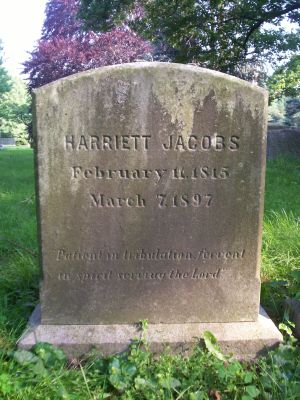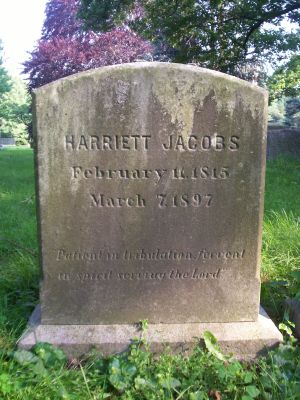
In the article that follows British Columbian historian and documentary editor, Mary Maillard, explores the controversy surrounding the precise birthdate of slave narrative author, Harriet Jacobs, and reminds us why precision matters.
Earlier this year (2013), numerous celebrations marked the two hundredth birthday of slave narrative author, Harriet Jacobs, and honored her extraordinary life of courage and activism. The year 1813, established through the evidence of an 1825 will, is accepted by most scholars as the year Harriet Jacobs was born. Yet Jacobs’ gravestone, inscribed with the birthdate February 11, 1815, hovers in the background like a spectral cautionary figure. What if the gravestone is right? Do two years matter? In an autobiographical work that has no dates, the birthdate matters. If Jacobs’ birth year is incorrect by two years, then so are some of the annotated events in her story, such as the birth of her brother, the deaths of her parents, and the births of her children. If we read Jacobs’ story through an 1815 lens, however, a myriad of discrepancies in her narrative evaporates.
The most compelling evidence that Harriet Jacobs was born in 1815 comes from Jacobs herself. She says in her preface to Incidents in the Life of a Slave Girl, “I remained in a Slave State twenty-seven years.” Jacobs fled North Carolina in June, 1842. The simple math tells us that she was born in 1815. Her obituary notice in the Boston Herald corroborates an 1815 birth. Her gravestone at Mount Auburn Cemetery in New York testifies to it. Jacobs’ daughter, Louisa, provided the information for the gravestone and we have no reason to doubt her. Louisa Jacobs lived with her mother for at least thirty of her adult years and she was with her during the winter of 1853-1854, when Jacobs began writing her book. If anyone knew Harriet’s story, it was Louisa Jacobs, particularly because it was partly her story too.
Arguments have been made that since there was little or inadequate documentation of slave births in the antebellum South, Harriet Jacobs did not know when she was born. Perhaps, but a lack of available documents today does not necessarily mean a lack of personal knowledge then. Harriet Jacobs’ narrative mentions no dates or real names (she wished to protect the identities of those who helped her escape) but it is peppered with numerous references to her age. We learn what she was doing when she was six, nearly 12, 14, 15, in her 16th year, 19, 21, and 27. Harriet Jacobs was literate and she was keeping count.
Outside references help us to date events in the narrative. Joshua Coffin recorded Jacobs’ escape to Philadelphia in June 1842. An 1835 runaway notice confirms when she went into hiding. The wills and estates of Margaret and Elizabeth Horniblow tell us how Harriet Jacobs’ family members were distributed after the deaths of their owners. Unfortunately, not everything lines up neatly in the narrative. As soon as we try to match narrative events with historical facts, glaring discrepancies leap off the page. For example, Harriet writes:
“When I was nearly twelve years old, my kind mistress sickened and died…we learned that she had bequeathed me to her sister’s daughter, a child of five years old….She possessed but few slaves; and at her death those were all distributed among her relatives. Five of them were my grandmother’s children….not one of her children escaped the auction block.”
Was Jacobs nearly twelve when her mistress sickened? Or when she died? Or both? We know that her owner, Margaret Horniblow, died in 1825 and that the child beneficiary, Mary Matilda Norcom, was three-years old in 1825. Jacobs’ brother, uncle, and grandmother were auctioned January 1, 1828. So how do we reconcile these inconsistencies? Is it a good idea to say that the author of her own true story is wrong, that she was not born in 1815, that the child was not five, that the auction reference is not right? Rather than discrediting Jacobs’ opening statement that she left North Carolina when she was 27, or rejecting the date on her gravestone, we should consider the effect of Lydia Maria Child’s editing on the manuscript.
In her introduction to the book, Child mentions the changes she made “for purposes of condensation and order.” If we keep in mind that Child collapsed time for her own reasons, we can absorb and accept the narrative’s contradictions as part of a larger work that no longer exists. We can make sense of the narrative without correcting or negating parts of it. Although Margaret Horniblow died in July 1825, her will was not proved until March 1826. It is doubtful that Jacobs would have gone to the Norcom household before the will was proved. The codicil that bequeathed Jacobs to the Norcom girl was not signed by Margaret Horniblow. If that seems irregular to us today, what did the Horniblow heirs think of it? Not much, it appears, judging by the fact that they contested the disposition of Jacobs and her family members for at least another eight years. If Jacobs was born in 1815, she was 11 when Margaret Horniblow’s will was proved. In late 1826 she was nearly 12 and the little niece almost five years old. By April 1827, Jacobs was 12 and the niece was five, and they were probably just getting to know each other.
Margaret Horniblow originally bequeathed Harriet, her brother John, her aunt Nancy, and her uncle Mark to her mother, Elizabeth Horniblow, who already owned Harriet’s grandmother, Molly. But Margaret’s will had barely been proven before Elizabeth Horniblow died in 1827. That year must have seemed a blur of change to Jacobs and perhaps incomprehensible to editor Lydia Maria Child. Elizabeth Horniblow’s estate, including Molly, Mark, and John, was sold off January 1, 1828. If we understand Jacobs’ incongruous text to be Child’s conflation of the deaths of two unnamed mistresses, Margaret Horniblow’s in 1825 and Elizabeth Horniblow’s in 1827, then we can understand how the narrative shoots so quickly to the January 1828 auction of the Jacobs family.
Harriet Jacobs wrote that her brother John was “two years younger than myself.” John’s 1850 census record and his Mount Auburn Cemetery burial document suggest a birth year of 1817/1818, and thus strengthen the evidence for an 1815 birth year for Harriet. When she was 15, Jacobs took up with the white lawyer, Samuel Tredwell Sawyer, and soon became pregnant. Her son Joseph’s premature birth and his first year are described in the chapter immediately preceding the discussion of Nat Turner’s rebellion of August 1831. Joseph was probably born in the late summer of 1830 while Harriet was still 15; according to Molly Horniblow’s 1830 census listing, he had not been born by June 1, but he does appear on a Sept 20 document. Joseph’s 1830 birth is reinforced by Mrs. Norcom’s appearance at her son’s May 1835, wedding supper. Harriet Jacobs says, “I had not met her face to face for five years.” She has already informed her reader that she had been living with her grandmother and “had not returned to my master’s house since the birth of my child.” In 1842, when Jacobs escaped from Edenton, North Carolina, Joseph was 12, exactly the age we would expect for a boy born in 1830.
Despite what seems to be overwhelming evidence for Joseph’s birth in 1830, a slight, disorienting discrepancy appears when we learn that before the winter and spring of 1835 Joseph “was now nearly five years old.” It is easy to see how a scholar might back up Joseph’s birth year to 1829 to reconcile this reference; if Joseph were born late in the year, he could still be 12 in 1842. But then we would be obliged to back up Harriet’s birthdate too, otherwise, she would be a 14-year-old mother. At this point, what time of year everyone is born really matters and we have to reconfigure everything. No matter how we look at it, the narrative’s timeline is inconsistent. I would suggest that here is an example of Lydia Maria Child’s re-ordering of the text. The question that could be rightly asked is, how do we determine what might be Child’s interference and what might be Jacobs’ truth?
Harriet Jacobs “had lived only nineteen years” by the time of the birth and baptism of her daughter Louisa. She was in her 19th year when Louisa was born [October 19, 1833] and she turned 19 four months later. Louisa’s October 19 birthdate is not in doubt because that is the day that she actually celebrated her birthday and it is also the date inscribed on her gravestone. She would have learned of her birthday from her owner, her great grandmother, her father who was now a North Carolina congressman, and her literate slave mother. In 1842, after Harriet had established herself in New York, Louisa Jacobs was nine years old, an age consistent with her estimated birth year of 1833.
In 1835, when Jacobs ran away from the Norcom plantation, both the newspaper runaway notice and her account state that she was 21 years old. If she were born in 1815, she would have been well into her 21st year. It was common practice in the nineteenth century to count age according to the year entered. Jacob’s February 11 birthdate is not in doubt because it is the day that Harriet celebrated her birthday and it also appears on her gravestone. Whether Harriet Jacobs was born on that day we will never really know for certain. What is important is that February 11 is the day she understood to be her birthday and it is the day from which she calculated her age while she wrote her narrative.

